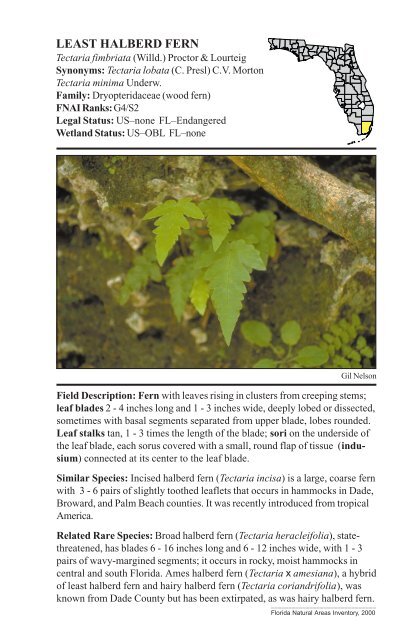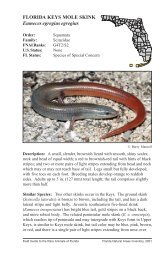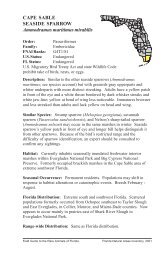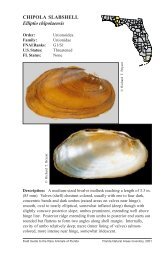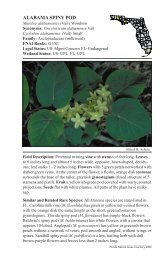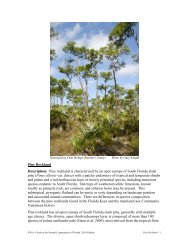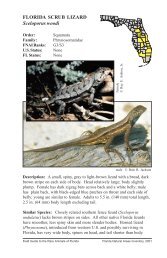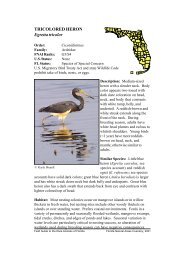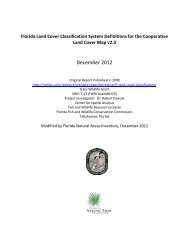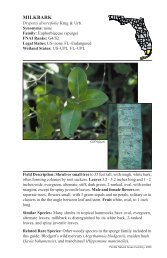Tectaria fimbriata - Florida Natural Areas Inventory
Tectaria fimbriata - Florida Natural Areas Inventory
Tectaria fimbriata - Florida Natural Areas Inventory
You also want an ePaper? Increase the reach of your titles
YUMPU automatically turns print PDFs into web optimized ePapers that Google loves.
LEAST HALBERD FERN<br />
<strong>Tectaria</strong> <strong>fimbriata</strong> (Willd.) Proctor & Lourteig<br />
Synonyms: <strong>Tectaria</strong> lobata (C. Presl) C.V. Morton<br />
<strong>Tectaria</strong> minima Underw.<br />
Family: Dryopteridaceae (wood fern)<br />
FNAI Ranks: G4/S2<br />
Legal Status: US–none FL–Endangered<br />
Wetland Status: US–OBL FL–none<br />
Gil Nelson<br />
Field Description: Fern with leaves rising in clusters from creeping stems;<br />
leaf blades 2 - 4 inches long and 1 - 3 inches wide, deeply lobed or dissected,<br />
sometimes with basal segments separated from upper blade, lobes rounded.<br />
Leaf stalks tan, 1 - 3 times the length of the blade; sori on the underside of<br />
the leaf blade, each sorus covered with a small, round flap of tissue (indusium)<br />
connected at its center to the leaf blade.<br />
Similar Species: Incised halberd fern (<strong>Tectaria</strong> incisa) is a large, coarse fern<br />
with 3 - 6 pairs of slightly toothed leaflets that occurs in hammocks in Dade,<br />
Broward, and Palm Beach counties. It was recently introduced from tropical<br />
America.<br />
Related Rare Species: Broad halberd fern (<strong>Tectaria</strong> heracleifolia), statethreatened,<br />
has blades 6 - 16 inches long and 6 - 12 inches wide, with 1 - 3<br />
pairs of wavy-margined segments; it occurs in rocky, moist hammocks in<br />
central and south <strong>Florida</strong>. Ames halberd fern (<strong>Tectaria</strong> x amesiana), a hybrid<br />
of least halberd fern and hairy halberd fern (<strong>Tectaria</strong> coriandrifolia), was<br />
known from Dade County but has been extirpated, as was hairy halberd fern.<br />
______________________________<br />
<strong>Florida</strong> <strong>Natural</strong> <strong>Areas</strong> <strong>Inventory</strong>, 2000
Least halberd fern<br />
<strong>Tectaria</strong> <strong>fimbriata</strong><br />
Habitat: Solution holes in limestone in rockland hammocks.<br />
Best Survey Season: All year.<br />
Range-wide Distribution: FL, Yucatan, Bahamas, and Greater Antilles.<br />
Conservation Status: Ten of the 15 known populations in FL are in small<br />
parks in Dade County. These populations are vulnerable to plant poaching,<br />
exotic species encroachment, and alterations of the water table.<br />
Protection & Management: Protect rockland hammocks from clearing,<br />
development, and lowering of the water table. Maintain shaded, moist<br />
conditions in hammocks. Eradicate exotic pest plant species. Enforce plant<br />
protection laws and prosecute plant poachers.<br />
References: Coile 2000, FNA 1993, IRC 1999, Lakela and Long 1976, Nauman<br />
1986, Nelson 2000, Wunderlin 1998, Wunderlin and Hansen 2000a,<br />
Wunderlin and Hansen 2000b.<br />
lower<br />
segments<br />
upper blade<br />
indusium<br />
sporangium<br />
sorus<br />
sori on underside<br />
of leaf<br />
______________________________<br />
<strong>Florida</strong> <strong>Natural</strong> <strong>Areas</strong> <strong>Inventory</strong>, 2000


